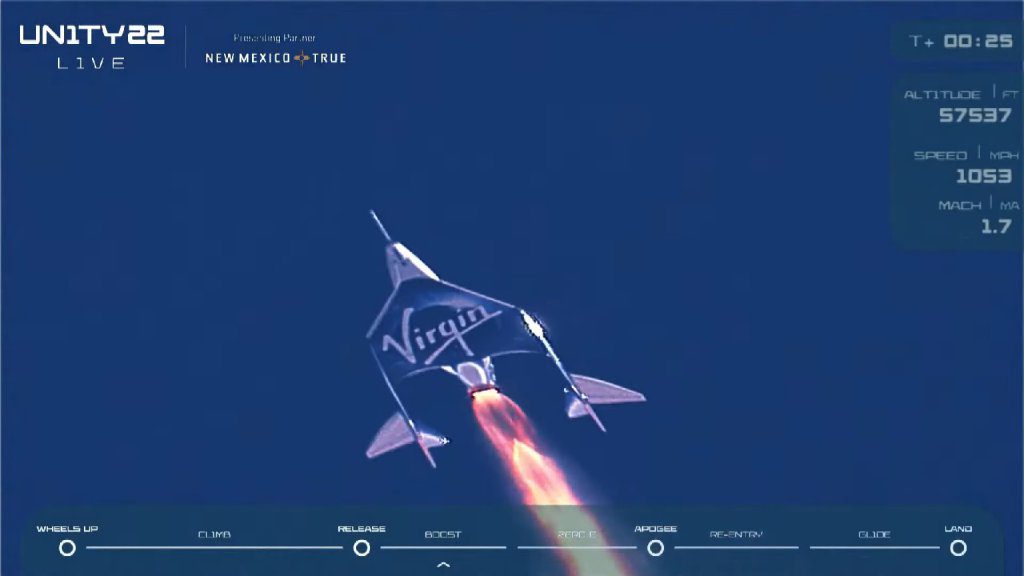On 11 July, Virgin Galactic founder Sir Richard Branson fulfilled a boyhood dream when he flew as ‘Astronaut 001” on his company’s SpaceShipTwo suborbital tourism vehicle, VSS Unity. He described it as “the experience of a lifetime” and “just magical”.
The Unity 22 mission began from New Mexico’s Spaceport America at 1440 GMT with the lift-off of the ‘Eve’ carrier aircraft, named after Branson’s mother. The Unity spacecraft separated from Eve at 1525 GMT and fired its engine for around 60 seconds to place it on a suborbital trajectory for a few short minutes of microgravity before gliding back to New Mexico for a perfect landing at 1538 GMT. Less than an hour later, Branson was awarded his ‘astronaut wings’ by veteran space station astronaut Chris Hadfield.

VSS Unity under its own power following release from its mothership. Courtesy of Virgin Galactic
Along with pilots Dave Mackay and Michael Masucci, Branson shared the cabin with three Virgin Galactic employees: chief astronaut instructor Beth Moses, lead operations engineer Colin Bennett and vice president of government affairs and research operations Sirisha Bandla. Apart from a poor, sometime non-existent, communications link between the cabin and the ground, the mission appeared to go without a hitch (albeit for the obligatory delay due to weather concerns). Along with some capable presenters in the studio, American comedian Stephen Colbert provided a typically self-centred commentary on the mission, making the event seem more like a tennis match than a space mission. Indeed, it would have received better media coverage in Europe in the following 24 hours were it not for a certain football match!
As part of his presentation, Branson announced an initiative intended to give more people a chance to become astronauts. Virgin Galactic plans to give away two tickets on a commercial flight in early 2022 as part of a sweepstake initiative with the charitable fund-raising platform Omaze. Pitching the initiative as a “self-propelling way” of allowing those who couldn’t otherwise afford “to go to space”, he said that “If enough people over the world participate, it just means the charity can keep on doing tickets for people.”
Arguably, of more long-term importance is the question of commercial viability: how will Virgin Galactic fare against its arch-rival Blue Origin in the space tourism stakes? By bringing his participation in “validating the space experience” forward, Branson beat Jeff Bezos into space by nine days (assuming Bezos’ New Shepard flight occurs as planned on 20 July). However, this is simply part of a battle of the billionaires for ‘space bragging rights’. Beyond a few early adopters, will budding astronauts feel they are receiving value for money from a quarter-million-dollar ticket that allows them just a few minutes of weightlessness? Interestingly, in a public relations coup, it was revealed before the flight that SpaceX billionaire Elon Musk has also booked a ride on the Virgin Galactic suborbital launcher.
The crucial marketing issue is, however, the definition of ‘space’. The widely recognised boundary to the space environment – acknowledged by the Fédération Aéronautique Internationale (FAI), the record-keeping body for astronautics – is the Kármán line at an altitude of 100 km. However, NASA and the US military defines the boundary as beginning at an altitude of 50 miles (about 80.5 km), which has historically allowed pilots of the X-15 rocket plane to claim their astronaut wings.
Branson’s Virgin Galactic mission reached an apogee of a reported 282,000 feet (which is about 86 km), while New Shepard is designed to exceed 100 km. In fact, Blue Origin Tweeted on 9 July: “From the beginning, New Shepard was designed to fly above the Kármán line so none of our astronauts have an asterisk next to their name. For 96% of the world’s population, space begins 100 km up at the internationally recognized Kármán line.” Interestingly, the BBC’s reporting of Branson’s mission included the phrase “to the edge of space”, which suggests a in-built recognition of 100 km as the key figure of merit. Expect to hear a lot more about this figure in the run up to the Bezos flight on 20 July.







